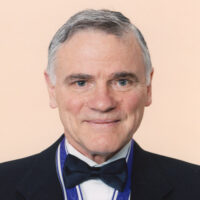
2002 Kyoto Prize Laureates
Biotechnology and Medical Technology
/ Biologist
1938 -
President and Director, Institute for Systems Biology
My Life and Adventures Integrating Biology and Technology
2002
11 /11 Mon
Place:Kyoto International Conference Center
From Genome Biology to Systems Biology
2002
11 /12 Tue
13:00 - 17:30
Place:Kyoto International Conference Hall
Dr. Hood conceived and realized the use of automated instruments in molecular biology and molecular genetics, fields which had hitherto depended primarily on the technical prowess of scientists. Through such innovations, he helped complete the mapping of the human genome, an extraordinary contribution to the advancement of life science and one that had been predicted to take nearly a century to accomplish.
Dr. Leroy E. Hood conceived and realized the use of automated instruments in molecular biology and molecular genetics, fields which had hitherto depended primarily on the technical prowess of scientists. Through such innovations, Dr. Hood helped complete the mapping of the human genome, an extraordinary contribution to the advancement of life science and one that had been predicted to take nearly a century to accomplish.
In the 1970s, scientists made important steps in the field of genetic engineering, foremost among which were DNA fragmentation and cloning and the subsequent technology of DNA sequencing. Such methods, however, required considerable time and skill on the part of scientists.
Dr. Hood developed a high-speed, automated peptide sequencer that was approximately 100 times more sensitive than previous instruments, making it possible to automatically identify the sequence of amino acids within proteins, key components of the human body. The dramatically increased sensitivity of Hood’s sequencer, which employed a gas-phase-based detection method, allowed scientists for the first time to analyze trace proteins in living organisms.
In 1984, Dr. Hood pioneered an automated peptide synthesizer and an automated DNA synthesizer, technologies that contributed to the rapid diffusion of PCR (Polymerase Chain Reaction), a DNA amplification technique developed around the same time. These important innovations facilitated and stimulated the subsequent remarkable progress in all areas of DNA research. In 1986, Dr. Hood announced the world’s first automated fluorescent DNA sequencer, a groundbreaking invention that made the deciphering of three billion genetic codes an attainable goal. This automation drastically reduced the time required for sequence determination and formed the prototype for the capillary DNA sequencer widely used today.
A working draft of the entire human genome sequence was published in 2001. This rapid advancement of the Human Genome Project was made possible in large part by Dr. Hood’s DNA synthesizer and sequencer.
The progress and achievements of genomics are expected to lead to revolutionary new medical applications, such as the specification of optimal methods of treatment for individuals. In addition, the deciphering of genetic information for other species will undoubtedly facilitate solutions for the food crisis and environmental problems as well as provide important insights into the history of life evolution. The various high-speed, automated instruments pioneered by Dr. Hood have been fundamental to progress in genomic science. For this reason, the Inamori Foundation is pleased to present the 2002Kyoto Prize in Advanced Technology to Dr. Leroy Edward Hood.
Profile is at the time of the award.